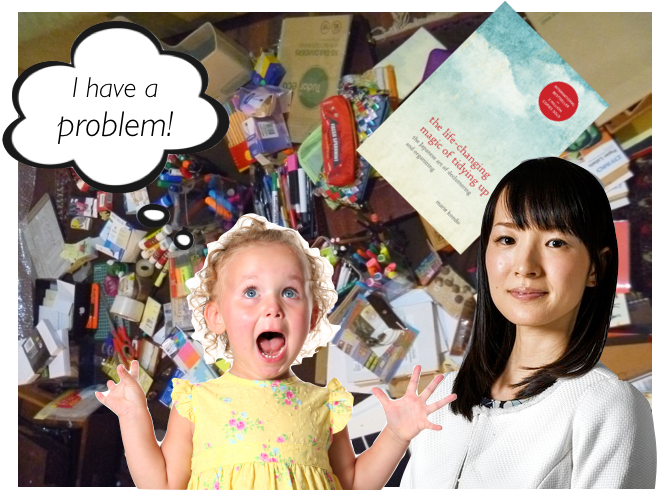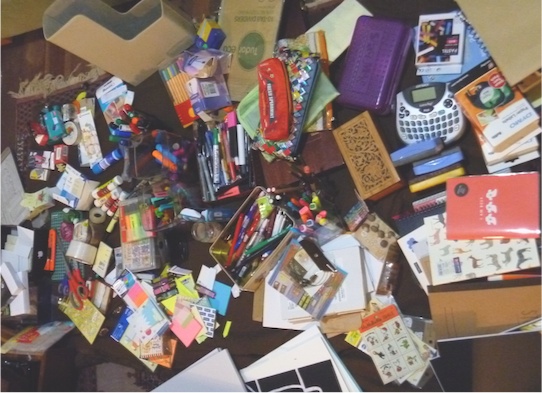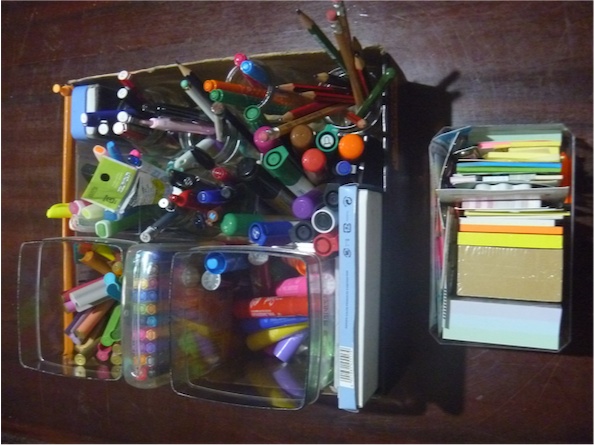
Marie Kondo took the world by storm with her bestselling book “The life-changing magic of tidying up”.
Her decluttering strategy (known as the KonMari method) is simple: Gather all the items in the same category (e.g. clothes, books or sentimentals), create a pile and then one by one, hold each item in your hands to see if it sparks joy. If it doesn’t spark joy, then away it goes!
I was skeptical of Kondo’s methods for a number of reasons but I recently decided to test out her strategy to organise my stationery.
You see, earlier this year I decided it was time to deal with my stationery addiction. It’s embarrassing to admit, but I had developed a bad habit of going stationery shopping every time I felt stuck with my PhD.
When the words weren’t flowing, off I would trot to the stationery store and I would usually leave with at least one new pen and notebook. If I was having a really bad day, I’d buy a packet of post-it notes too.
For some reason I had developed the irrational belief that new stationery (e.g. a new pen, notebook and post-it notes) equated with new ideas and inspiration. I thought new pens would result in greater creativity and productivity levels.
Well, the pens and notepads didn’t. They never did. But somehow I thought the next notepad or new highlighter pen would be the answer to my problems.
When I finally came to the realisation of how crazy this thinking was, I stopped going to the stationery store and started using what I already had. This lasted for 6 months.
Then came the day when I relapsed.
I went to Japan: the land of the most bizarre and wonderful stationery I’ve ever seen.
Again, I was hooked. This stuff was way too cute to resist.
When I came home to Australia after a month of living in Japan, you can probably imagine that I didn’t just have a pencil case with a few pens to declutter and organise.
In fact, once I gathered all my stationery and put it in one place (Marie Kondo style), it took up a third of my lounge room floor.

Now, this is where the true magic power of Kondo’s method arises: The sight of all that stationery made me feel sick. I felt totally embarrassed and overwhelmed. How many pens did I really need? I had let things get out of control in the stationery department. I knew I had to take control of the situation.
Now here is the point where Ms Kondo and I part ways. Marie Kondo’s philosophy is “If it doesn’t spark joy, then it’s time to get rid of it!”. But I can’t bring myself to throw away useful stationery made from precious resources.
In the end, I did end up throwing away some things (e.g. pens that no longer worked). I also gave away some cute Japanese stationery to my friends and niece.
But most of my stationery I kept and organised in one place. All my notepads together. All my post-it notes together in one container. All my pens for visual note taking in a neat little shoebox (Note: Kondo says shoeboxes are the only storage item you will ever need).

The problem was I had accumulated all this stuff but because it was spread out all over the house I had forgotten I already had over 100 pens, 10 blank notepads and 5 visual diaries!
After completing the KonMari method, I know exactly what I have. In fact, I know that I have enough stationery to last me for at least 5 years! The desire to consume stationery has gone, which is interesting since Marie Kondo says towards the end of her book “After tidying many clients tell me that their worldly desires have decreased”.
I have noticed that I have a deeper appreciation of the pens, notepads and post-it notes that I already have.
So for that, I thank you Marie Kondo for sharing your magic powers with me.
Share This:

This means you need to prepare yourself mentally and physically for them.
You can work so hard to memorise large quantities of information for an exam, but if you’re not mentally and physically prepared, all that hard work can sadly go to waste.
When it comes time to take your exams, you have to relate to yourself as a professional athlete. Leading up to the day of the big performance (i.e. the exam), you need to eat nutritious food, be in the right frame of mind, manage your nerves, and allow your body to rest. These simple things can make all the difference to your exam performance.
You may be thinking “But isn’t this just common sense?”
It is! But creating healthy habits takes time and practice.
It’s one thing to intellectually know you should be eating well but it’s another thing altogether to incorporate healthy meals and snacks into your lifestyle.
I see a lot of students drinking energy drinks, getting very little sleep, and eating highly processed foods in the days leading up to exams. I have to admit, there was a time when I engaged in these behaviours too. I can tell you from personal experience, this is a recipe for mediocre grades and a miserable existence.
Here are my top 10 tips to prevent burnout and boost exam performance:
Sleep is critical to the learning process, exam performance, and wellbeing. Yet it’s usually the first thing students sacrifice to get more study done.
If you miss two hours of sleep each night for a week, the cognitive effects are as bad as going without sleep for two days straight!
Studies have also found that if you stay awake for 18 hours straight that’s like having a blood alcohol level of 0.05. In other words, it’s like being legally drunk. Your ability to focus, think, and learn will be seriously impaired.
You can’t adapt to getting less sleep. As adolescents, you need about 9-10 hours of sleep per night to be as alert as possible when you wake up.
If that feels unachievable, try to just get an extra 15 minutes of sleep tonight. Gradually increase this each night until you reach your target.
Often students stop exercising when they start preparing for exams. They think “I don’t have time to exercise!”. It’s as if they think they must spend every moment studying. Don’t fall into this trap.
Movement is your friend when it comes to studying for exams.
Research shows engaging in regular physical movement will help you to study more effectively. Firstly, it’s a great way to relieve stress and release feel good chemicals. Secondly, it gets the blood flowing more efficiently to your brain, which can give you a cognitive boost.
One study found students who engaged in 5 minute movement breaks every 17 minutes during a lecture retained more information and could focus better.
Every time you engage in a short movement break, you’re enhancing your study sessions.
Research has found that students who skip breakfast experience a decrease in cognitive performance and alertness compared to students who eat breakfast.
Eating a nutritious breakfast will give you a cognitive boost before an exam. It will also help you to feel fuller for longer, stabilise your mood, and give you plenty of energy to get through the exam.
Here are some healthy breakfast ideas:
Muesli or porridge with nuts and fresh fruit (e.g., berries) Wholemeal toast with a variety of toppings (e.g., baked beans, tomatoes, and avocado) and a piece of fruit A healthy homemade smoothie (click here for my brain boosting smoothie recipe)

Your brain requires adequate hydration to function properly. Drinking water ensures that your brain receives the necessary fluids to perform tasks efficiently, such as retaining information and problem-solving.
Take regular sips of water as you study. It’s a good idea to have a glass of water or a reusable drink bottle within arms reach.
You may even want to create a tiny habit to remind yourself to engage in this simple behaviour (e.g., “After I finish answering a practice exam question, I will take a sip of water”).
Many years ago, I started thinking that my teachers and lecturers were out to get me. I thought they would mark me down wherever they got the chance. As a result of this distorted thinking, I became too scared to write anything in one of my first tests at law school. After receiving a terrible grade (5%), my brother said to me:
“Remember sis, your teachers want you to do well. They will try to give you marks wherever they can. It’s in their best interest to do so.”
Don’t worry about writing a perfect answer. If you’re unsure, be brave and still write something down. Even if it’s just a few dot points, it’s better than nothing. You may not get any marks for it, but your teachers won’t take marks off.
Just remember, most of the time your teachers are on your side and they want you to succeed. When you do well, it makes them look good.
Chances are there will always be something that you could have studied more thoroughly come the day of your exam. But on the morning of an exam, you can’t do much about that, so there’s no point worrying. Worrying will just deplete your finite energy, which you need to conserve for the exam.
Instead of worrying, try saying this to yourself before each exam:
“I now know so much more than I did before. I’ll be able to answer many questions in this exam.”
Telling yourself this positive micro-thought will allow you to enter the exam in a calm and confident frame of mind.
It’s normal to feel a bit nervous before an exam. But there are certain things and people that can push your anxiety levels into dangerous territory and impair your exam performance.
For example, coffee and energy drinks will skyrocket your stress levels. Similarly, hanging out with people who have a lot of nervous energy and are venting about the exam (“I’m going to fail!” and “I hardly studied!”) are going to leave you feeling distracted and a little jangled.
Before the exam, do your best to isolate yourself from these people. If you’re worried about offending someone who is venting to you, you could say “I’m sorry but I really need to do some last minute cramming”. Then proceed to pull out your notes and pretend to read them.
How many times have you stayed back after an exam to talk to your friends about what you put for each question? Have you ever felt terrible after doing this?
It can be reassuring to know that you wrote the same answer as your friends. But if you find out that you wrote something completely different, you may start to second guess yourself. If you have another four or five exams to go, this may throw you off your game.
This is why I don’t recommend engaging in a postmortem of the exam until you get your results/exam paper back.
When you walk out of the exam room, tell yourself:
“That exam is over. There’s nothing I can do to change how I went. It’s time to move on!”.
You could imagine yourself locking the exam in a box and throwing it off a cliff or rolling it up and stuffing it in a bottle and throwing it out to sea. The point is you need to mentally disconnect from that exam and focus on studying for the next one.

If you come across a question that you’re not sure how to answer, stop for a moment and take a few deep breaths (in for the count of 4 and out for the count of 4).
A simple breath activity you can try is the Box Breathing Technique. This involves imagining yourself breathing along the sides of a box (breathing in for the count of four on one side, out for the count of four on the next side, etc). Repeat this 2-3 times. Then take a look at the question again.
If you are still unsure how to answer the question, move on to another question.
The worst thing you can do is panic (remember, stress impairs your ability to think and recall information).
By engaging in Box Breathing, you can help yourself to remain in a calm and stable state.
Many of us are familiar with writer’s cramp. This can be caused by gripping onto your pen too tightly. Try loosening your grip a little.
Alternatively, experiment with a range of different pens. Some biros require you to press down hard on the page to make a mark, but not gel pens. The ink just flows onto the page!
The reality is, even with a good gel pen, your elbow will start to hurt at some point if you’re taking a 3 hour exam. When it does start to hurt, have a rest for a few seconds (yes, you have time to do this). Stretch your arm out. Shake it a little.
Treat each exam like a mountain hike rather than a 100 metre sprint. Resting for a few moments here and there will be time well spent and will enhance your overall performance.
These simple strategies can help to elevate your exam performance. My advice is to start small. Even if your exams are several weeks away, select one or two of these ideas and start testing them out today. At first, the strategies will require a bit of mental effort. But like anything in life, if you persevere they’ll become second nature to you and they’ll just be things you do without even thinking.
Want to learn more exam strategies? Click here to download a free copy of 70 ways to ace your exams.
I love the feeling.
I think, “Go me! Look at you go!” as I strike the pen through the list item.
But as good as it feels to cross things off, it’s not really about that. That’s not where the power of lists resides.
The power exists in making the list in the first place. Getting the thoughts out of your head and down on paper.
In his book Keep going: 10 ways to stay creative in good times and bad Austin Kleon states:
“Lists bring order to the chaotic universe. I love making lists. Whenever I need to figure out my life, I make a list. A list gets all your ideas out of your head and clears the mental space so you’re actually able to do something about them.
When I’m overwhelmed, I fall back on the old-fashioned to-do list. I make a big list of everything that needs to get done, I pick the most pressing thing to do, and I do it. Then I cross it off the list and pick another thing to do. Repeat.”
When I’m feeling really under the pump, I’ll go for a walk and scribble out a list while I’m walking.
I’m not sure which activity helps me more – the walking or the list making – but by the time I arrive home from my walk, I always feel less anxious and more in control.
If you haven’t been having much luck with to-do lists, you may have fallen into one of the following common traps:
If you look at your list and it says says things like ‘Mum’s birthday’ or ‘Study’, it’s time to make these list items crispy.
Crispy is a Behaviour Design term created by Stanford university Professor BJ Fogg. When you make a behaviour crispy, you get really clear on the specific behaviour you need to carry out.
Here are some examples I came up with to illustrate the difference between fuzzy and crispy list items:
Fuzzy to-do list item: Mum’s birthday
Crispy to-do list item: Call mum to wish her happy birthday after lunchFuzzy to-do list item: Study
Crispy to-do list item: Open Quizlet study deck and test myself for 5 minutes on the bus
When you ‘crispify’ a list item, you tighten it up. You make it crystal clear for your brain what you need to do next. This in turn makes it much easier for you to get started.
If your list is no longer working for you, feel free to abandon it and create a new one. As Psychiatrist Douglas Puryear says in his book Your life can be better:
“I make lists over and over, all day long. It’s not just about having the list; there is also benefit in making them. Writing down what I need to do is somehow calming and organizing, and therefore motivating. When I write things down, it’s as though I’m on top of them.”
Our brains get bored easily, so try making your list a little bit different every now and then.
Here are some simple ideas on how you can jazz up your next to-do list:
It doesn’t matter what medium or what materials you use to create your to-do list. What matters is that you get everything out of your head and you make each list item crispy.
If your to-do list is causing you to have a mini meltdown, back up. Ask yourself . . .
“Is this list too long? Can I cross a few things off?”
Create a short list from your big list – just three items (post-it notes are good for this). Then put away your long list. When you’ve completed those three items, create a new list of three from your long list.
During times of chaos, lists are your friends. Reach out and use this fabulous tool to lighten your mental load. You don’t need any special skills or talent to do this. Lists are for everyone.
It certainly can be.
If you’re spending hours of your day, dusting, picking up bits of fluff off the carpet and scrubbing floors, then yes. You’ve got a bad case of procrastacleaning.
Put simply, you’re avoiding living.
As professor (and expert on procrastination) Tim Pychyl says:
“Procrastination is an existential issue of not getting on with life itself”.
When I was at university, I had a friend whose parents were hardcore house cleaners. They spent a huge amount of their time cleaning.
Their house had a distinct chemical smell: Pine O Cleen.
Like a hospital surgery room, everything was so neat. So immaculate. So sterile.
The backyard was the same: brick paving as far as the eye could see. No trees. No flowers. No birds. No life.
One day, out of the blue, I received a phone call from my friend. She was really upset. She had just received the terrible news that her mum had late stage cancer.
I remember my friend saying things like, “Mum isn’t ready to die”, “There’s all these things mum still wants to do” and “Mum wanted to go travelling . . . ”. But her mum was now too sick to do anything or go anywhere. She’d missed her chance.
Not long after that phone call, I became friends with a Bohemian family. And oh boy, did they know how to live!
I would go over to this family’s house and we’d do things like pick olives in our muddy gumboots, trample back into the house and sip on cups of tea surrounded by piles of books, academic papers and trinkets gathered from various adventures.
In this Bohemian household, no one cared about mud on the floor or decluttering. What mattered most were projects, ideas, relationships and good food!
So I decided cleaning and organising was a waste of time. I embraced a life of mess and clutter.
It’s fun being a slob up to a point. But then life becomes really hard work. Much too hard for a slob to handle. For example:
• You waste time running around the house looking for things (e.g. your car keys and assignment sheets)
• You buy things you don’t need (you forgot you already have the item or something similar)
• You feel mentally chaotic being surrounded by piles of work and clutter
• It’s much harder to focus on one thing at a time
• You lose track of all the things you need to do
• You feel like you don’t have enough time to do everything (because you don’t have a clear mental picture of what needs to be done)
I soon realised I had to strike a balance between the hardcore cleaners and the Bohemian family. When I started working on my PhD, I knew it was time to break my slobby, pack rat habits and get organised to complete this big project.
I didn’t want to spend hours of my precious life energy cleaning. And as a poor student, I didn’t have the money to hire a cleaner.
So I embraced the power of The Tiny Tidy.
A Tiny Tidy is an intense three-minute tidy-up session. It delivers quick results and leaves you feeling more optimistic about your life.
In his excellent book Tiny Habits BJ Fogg explains how to execute the strategy as follow:
“Go to the messiest room in your house (or the worst corner of your office), set a timer for three minutes, and tidy up. After every errant paper you throw away, celebrate. After every toy you toss back into its cubbyhole – you get the idea. Say, “Good for me!” and “Wow. That looks much better.” And do a fist pump. Or whatever works for you. Celebrate each tiny success even if you don’t feel it authentically, because as soon as that timer goes off, I want you to stop and tune into what you are feeling.
I predict that your mood will be lighter … You will be more optimistic about your day and your tasks ahead. You may be surprised at how quickly you’ve shifted your perspective. I guarantee that you will look around and feel a sense of success. You’ll see that you made your life better in just three minutes.”
The celebration part of the Tiny Tidy is essential. Don’t bypass it. Every item you deal with must be followed with a “Woohoo!”, fist pump or celebratory dance move. This is what helps wire in the new habit of doing the Tiny Tidy sessions.
I have found doing a Tiny Tidy session once a day keeps chaos at bay. As Marian Petre and Gordon Rugg state in the The Unwritten Rules of PhD Research:
“Tidying and filing, if you do them in manageable doses can be very soothing activities and can give you a feeling of control.”
Life is short and there’s lots of stuff to do and explore. Who wants to spend all their time cleaning?
Famous artist Margaret Olley was well known for her cluttered, messy house. And she had a great philosophy when it came to cleaning. She said:
“I’ve never liked housework. I get by doing little chores when I feel like them, in between paintings. Who wants to chase dust all their life? You can spend your whole lifetime cleaning the house . . .”
Her advice was simple:
“If the house looks dirty, buy another bunch of flowers”.
My advice is save your money. Don’t buy any flowers (pick some from the garden and put them in a jar) and try a Tiny Tidy in between study/work sessions.
It’s a good idea to do a couple of Tiny Tidy sessions over the weekend so you can start the week with some kind of order.
Trust me, three minutes here and there adds up. Before you know it, you’ll be looking at a very different work/living space and feeling way more in control.
So whatever it is you want to do in life, go do it. Remember, life is for living (not for cleaning).
Dr Jane Genovese delivers interactive and engaging study skills sessions for Australian secondary schools. She has worked with thousands of secondary students, parents, teachers and lifelong learners over the past 15 years.
Get FREE study and life strategies by signing up to Dr Jane’s newsletter:
© 2024 Learning Fundamentals